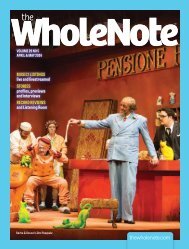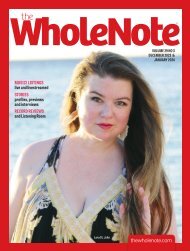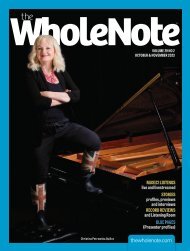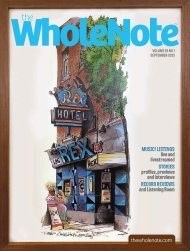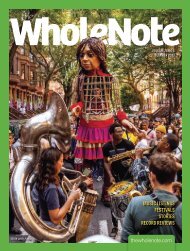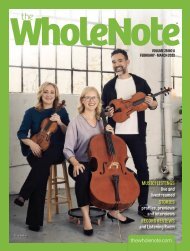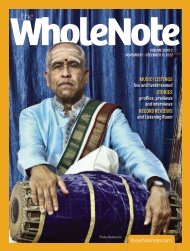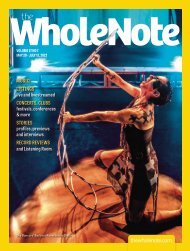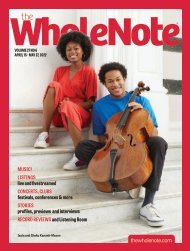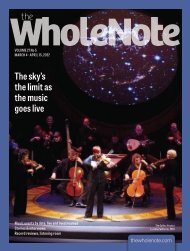Volume 27 Issue 3 - December 2021 / January 2022
Many Happy Returns: the rebirth of Massey Hall -- from venue to hub; music theatre's re-emergence from postponement limbo; pianist Vikingur Ólafsson's return visit to to "Glenn Gould's hometown"; guest writer music librarian Gary Corrin is back from his post behind the scenes in the TSO library; Music for Change returns to 21C; and here we all are again! Welcome back. Fingers crossed, here we go.
Many Happy Returns: the rebirth of Massey Hall -- from venue to hub; music theatre's re-emergence from postponement limbo; pianist Vikingur Ólafsson's return visit to to "Glenn Gould's hometown"; guest writer music librarian Gary Corrin is back from his post behind the scenes in the TSO library; Music for Change returns to 21C; and here we all are again! Welcome back. Fingers crossed, here we go.
Create successful ePaper yourself
Turn your PDF publications into a flip-book with our unique Google optimized e-Paper software.
Florence Price<br />
(1887-1953), a<br />
native of Little Rock,<br />
Arkansas and a<br />
graduate of Boston’s<br />
New England<br />
Conservatory of<br />
Music, was a pianist<br />
and composer who,<br />
despite enjoying a modicum of recognition<br />
during her lifetime (including having her<br />
Symphony No. 1 in E Minor premiered in<br />
1933 by Frederick Stock and the Chicago<br />
Symphony Orchestra, a first for an African-<br />
American woman) was a composer whose<br />
work was almost lost to history. As the<br />
charming illustrated children’s book Who is<br />
Florence Price?, written by students of the<br />
Special Music School at New York’s Kaufman<br />
Music Center recounts, a box of Price’s<br />
dogeared and yellowed manuscripts of<br />
original compositions and symphonic works<br />
was found (and thankfully not discarded) in<br />
2009 in a dilapidated attic of the Chicago-area<br />
summer home in St. Anne, Illinois in which<br />
Price wrote. This discovery has led to what<br />
could be described as a Price renaissance,<br />
with multiple recordings, premieres, the<br />
dissemination power of the Schirmer<br />
publishing house (that acquired worldwide<br />
rights to Price’s catalogue in 2018), and, most<br />
recently, two excellent discs that capture the<br />
American composer’s elegant music in its<br />
full glory.<br />
Rooted in the<br />
European Romantic<br />
compositional<br />
tradition that was<br />
her training, but<br />
blended with the<br />
sounds of American<br />
urbanization, the<br />
African-American<br />
church, as well as<br />
being imbued with<br />
elements of a folkloric<br />
vernacular<br />
blues style, Price’s Symphonies 1 & 3 (on<br />
Deutsche Grammophon) and the never before<br />
recorded Ethiopia’s Shadow in America<br />
(Naxos American Classics) come to life with<br />
tremendous splendor and historical gravitas<br />
in the capable hands of Yannick Nézet-<br />
Séguin and The Philadelphia Orchestra and<br />
the ORF Vienna Radio Symphony Orchestra<br />
respectively.<br />
Of note is Price’s under-recorded The<br />
Mississippi River, that ORF conductor<br />
John Jeter suggests captures “the depth of<br />
the American experience… like no other<br />
composer.” Articulating in sound the experience<br />
of the Great Migration, the large-scale<br />
movement and relocation of African-<br />
Americans from the Southern United States to<br />
such Northern locales of employment, urbanization<br />
and distance from “Jim Crow” laws as<br />
Chicago, Detroit and New York, that was both<br />
compositional fodder for Price and her own<br />
lived experience.<br />
The book and two discs represent tremendous<br />
strides towards greater inclusion and<br />
representation within the canon and, at least<br />
for this reviewer, facilitated the discovery of a<br />
creative and exceptional new musical voice.<br />
Andrew Scott<br />
Americascapes<br />
Basque National Orchestra; Robert Trevino<br />
Ondine ODE 1396-2 (naxosdirect.com/<br />
search/ode+1396-2+)<br />
! Alsace-born<br />
Charles Martin<br />
Loeffler (1861-1935)<br />
moved to the U.S. in<br />
1881. His 25-minute<br />
“Poème dramatique,”<br />
La Mort de<br />
Tintagiles, Op.6<br />
(1897), based on a<br />
play for marionettes by Maurice Maeterlinck<br />
about a murderous queen, is definitely<br />
“dramatique.” Between its stormy opening<br />
and mournful close, Loeffler’s lushly scored,<br />
ravishing music conjures a scenario of<br />
sensuous longing and dangerous conflict,<br />
with long-lined, arching melodies and<br />
vibrant orchestral colours redolent of French<br />
late-Romanticism-Impressionism. I loved it;<br />
why isn’t it better known?<br />
Carl Ruggles (1876-1971) depicted his<br />
wife and three friends, including Charles<br />
Ives, in his four-movement, ten-minute<br />
Evocations (1943), orchestrated from earlier<br />
piano pieces. Hardly affectionate music, it’s<br />
austere and perturbed. To me, Ruggles’ very<br />
name embodies what I hear in all his music,<br />
including Evocations – rugged struggles.<br />
The cinematically rhapsodic Before<br />
the Dawn, Op.17 (1920), anticipates the<br />
many beauties that would be heard in the<br />
symphonies of Howard Hanson (1896-1981),<br />
his first appearing just two years later. The<br />
brief (under seven minutes) tone poem here<br />
receives its long overdue, first-ever recording.<br />
Henry Cowell (1897-1965) spent the winter<br />
of 1956-1957 in Iran, part of a tour jointly<br />
subsidized by agencies of the U.S. and Iranian<br />
governments. Three works resulted: Persian<br />
Set, Homage to Iran and the 19-minute<br />
Variations for Orchestra (1956) recorded here.<br />
It’s filled with exotic sonorities hinting at<br />
arcane magic and nocturnal mysteries.<br />
Thanks to conductor Robert Trevino and<br />
the Basque National Orchestra for these revelatory<br />
performances of four almost-forgotten<br />
American works.<br />
Michael Schulman<br />
MODERN AND CONTEMPORARY<br />
New Jewish Music Vol.3<br />
Sharon Azrieli; Krisztina Szabó; Nouvel<br />
Ensemble Moderne; Lorraine Vaillancourt<br />
Analekta AN 2 9263 (analekta.com/en)<br />
! The Azrieli<br />
Foundation has<br />
released their<br />
recording of this<br />
year’s composition<br />
prize for new<br />
Jewish music,<br />
along with recordings<br />
of commissioned<br />
works in the categories of Canadian<br />
Composition and Jewish Music: Yotam<br />
Haber’s Estro Poetico-armonico III in the<br />
latter, Keiko Devaux’s instrumental work<br />
Arras in the Canadian category. Yitzhak<br />
Yedid’s Kadosh Kadosh and Cursed won<br />
the prize for an existing work of Jewish<br />
Music. Dissidence, a concise and somewhat<br />
anachronistic work for small orchestra<br />
and soprano (Sharon Azrieli, a fine soprano<br />
and founder of the prize) by the late Pierre<br />
Mercure, rounds out the disc.<br />
Kadosh… is concerned with Jerusalem’s<br />
Temple Mount, the place shared as sacred by<br />
three major religions. Embattled chattering<br />
and shouts introduce Yedid’s work, followed<br />
by brassy bombast and unison modal melody<br />
in alternation, depicting conflict, even<br />
violence. A middle section provides relief,<br />
insofar as mourning relieves cataclysm.<br />
The individual players of Montreal’s excellent<br />
Nouvel Ensemble Moderne get a brief<br />
chance to sing before hostilities recommence,<br />
devolve into a nasty Hora, returning tragically<br />
to increasing strife. By the end of the movement,<br />
we’re hoping, nay praying for peace.<br />
Hope deferred, the heart is sick. A chant<br />
melody in the piano calls through maddened<br />
violin scratches and braying brass. Yedid<br />
seems pessimistic; in spite (or because) of the<br />
spiritual importance of the Temple Mount,<br />
hostilities persist.<br />
The formidable mezzo Kristina Szabó joins<br />
the ensemble for Haber’s work, a complex<br />
piece with so much historical/textual weight<br />
it deserves a review unto itself. Highly<br />
effective writing.<br />
Arras is a woven tableau, relying on<br />
breath and bow effects, microtonal vibrato<br />
and dissonances, and shifting background<br />
textures to frame lush, even lurid melody. A<br />
single movement of nearly 25 minutes’ length,<br />
it makes a patient argument for beauty.<br />
Max Christie<br />
thewholenote.com <strong>December</strong> <strong>2021</strong> and <strong>January</strong> <strong>2022</strong> | 41




